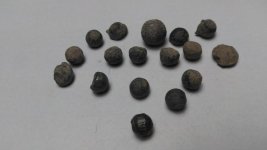IfindFe
Junior Member
I used to reload ammo, and cast my own bullets. But I know very little about muzzle loaders or cast ball ammo. I found this group of .38 cal. balls, with the one .55 cal. ball close by. The .38 cal. balls have a somewhat flattened and striated "belt" around the equator. The sprue is always at a pole compared to the belt. I cleaned the ball at bottom of photo for a better look at the striations. The striations do not look like any kind of rifling marks to me. They don't look like mold marks to me. The flattened "belt" doesn't make any sense to me. All of these .38 cal. balls are like this.
These were in a draw near an old cemetery. I'm certain it was a target practice spot. I'm in Milton-Freewater, Oregon. Our area didn't begin to be settled until about 1860. I occasionally find old rimfire and internal primer cartridge cases.
Any help out there? I'm really curious about the striated belts.
These were in a draw near an old cemetery. I'm certain it was a target practice spot. I'm in Milton-Freewater, Oregon. Our area didn't begin to be settled until about 1860. I occasionally find old rimfire and internal primer cartridge cases.
Any help out there? I'm really curious about the striated belts.


